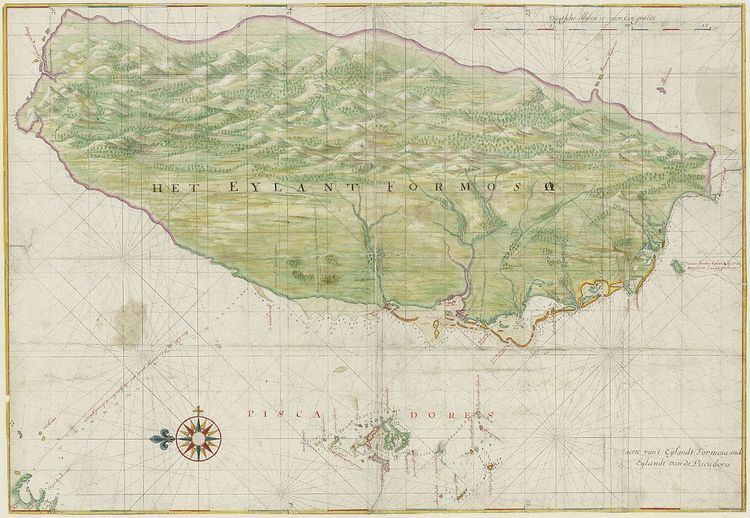 | ||
Dutch Formosa (1624–1662)
The Dutch Empire, during the period of the Dutch United Provinces and under the auspices of the Dutch East India Company (VOC), attempted to conquer Macau in 1622. Later they colonized the Pescadores Islands, where they built a fort in Makung. In 1624, the Chinese attacked, and the Dutch were driven to Taiwan (then called Formosa, meaning "beautiful island"). That year they established Fort Zeelandia on Taiwan's southwest coast. In 1637, the Dutch conqurered Favorolang (also Favorlang; present day Huwei, Yunlin). The names listed here are the Dutch governors:
Contents
- Dutch Formosa 16241662
- Spanish Formosa 16261642
- Kingdom of Tungning 16621683
- Taiwan under Great Qing First period 16831721
- Taiwanese revolt 1721
- Taiwan under Great Qing Second period 17211895
- Republic of Formosa 1895
- Taiwan under Japanese Empire 18951945
- Taiwan under Republic of China 1945 Present
- References
Spanish Formosa (1626–1642)
In response to the Dutch settlements, the Spanish settled at Keelung on the northeast coast of the island in 1626 and built Fort San Salvador. Later they built another outpost, Fort San Domingo, at Tamsui in the northwest. In 1629 these forts had a combined total of about 200 Spaniards and 400 Filipinos. By 1635, the Tamsui settlement was abandoned; however, the Keelung settlement remained in Spanish hands until 1642, when a Dutch force of 11 ships and 1,000 men attacked the fort of 446 people. The Spanish surrendered.
Kingdom of Tungning (1662–1683)
The Southern Ming (Ming Dynasty loyalists) invaded Taiwan under Koxinga, expelling the Dutch and capturing Fort Zeelandia. They established the Kingdom of Tungning.
* Regency of Feng Xifan from 1682 to 1683.
Taiwan under Great Qing (First period, 1683–1721)
Taiwanese revolt (1721)
Taiwan under Great Qing (Second period, 1721–1895)
Republic of Formosa (1895)
Following its defeat in the First Sino-Japanese War (1894–1895), China ceded Taiwan and the Pescadores to the Empire of Japan in perpetuity, with a grace period for inhabitants wishing to remain Qing Dynasty subjects to sell their property and return to the Great Qing. The date set for the handover was June 2, 1895.
However, the Republic of Formosa was formed on May 25, 1895 by a group of Qing officials and local gentry with its capital at Tainan to resist impending Japanese rule. The republic lasted for less than six months; on October 21, 1895 Imperial Japanese Army forces entered the capital and quelled the resistance. The Republic of Taiwan had two presidents:
Taiwan under Japanese Empire (1895–1945)
After establishing control over the island, the Japanese used the French Empire model of an occupying force and were instrumental in the industrialization of the island; they built railroads, a sanitation system and a public school system, among other things. Around 1935, the Japanese began an island-wide assimilation project to bind the island more firmly to the empire.
In 1941, war broke out when the Japanese attacked the U.S. naval port of Pearl Harbor in Hawaii. By 1945, desperate plans were in place to incorporate popular representation of Taiwan into the Imperial Diet to end colonial rule of the island and transfer occupying troops to the front lines to fight the Allies. The names listed here are the Japanese governor-generals:
Military Rikken Seiyūkai Kenseikai Rikken Minseitō
Taiwan under Republic of China (1945-Present)
Following the end of World War II in 1945, under the terms of the Instrument of Surrender of Japan, Japan provisionally accepted the Potsdam Declaration (which referenced the never-signed Cairo Declaration), under which the island was to be transferred to the Republic of China. ROC troops were authorized to come to Taiwan to accept the surrender of Japanese military forces on behalf of Allied Powers in General Order No. 1, issued by Douglas MacArthur, the Supreme Commander of the Allied Powers, on September 2, 1945. ROC troops were later transported to Keelung by the U.S. Navy, and Japanese handed the control of Taiwan to the ROC on October 25, 1945. Following its defeat in the Chinese Civil War in 1949, Premier Yan Xishan proclaimed the ROC Government's relocation to Taiwan (where it exists until today), thus replacing the Provincial Chairperson as the highest-ranked executive official on Taiwan. This lasted until March 1950, when Chiang Kai-shek resumed his duties as President in Taipei.
Kuomintang Democratic Progressive Party
